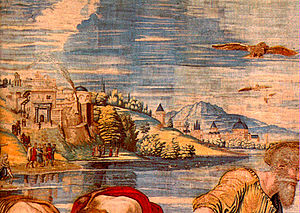Vatican Hill
| Vatican Hill | |
|---|---|
St Peter's Basilica |
Vatican Hill (
Etymology
The
We have been told that the word Vatican is applied to the hill, and the deity who presides over it, from the vaticinia, or prophecies, which took place there by the power and inspiration of the god; but Marcus Varro, in his book on Divine Things, gives another reason for this name. "As
Aius," says he, "was called a deity, and an altar was built to his honour in the lowest part of the new road, because in that place a voice from heaven was heard, so this deity was called Vaticanus, because he presided over the principles of the human voice; for infants, as soon as they are born, make the sound which forms the first syllable in Vaticanus, and are therefore said vagire (to cry) which word expresses the noise which an infant first makes".[2]
Vaticanus is more likely to derive in fact from the name of an
Topography of ancient Rome
Vaticanus Mons (or Vaticanus Collis[5]) was most often a name in Classical Latin for the Janiculum.[6][1] Cicero uses the plural form Vaticani Montes in a context that seems to include the modern Vatican Hill as well as the Monte Mario and the Janiculan hill.[7][1]
The
The Vaticanum was also the site of the Phrygianum, a temple of the
Vaticanus Mons came to refer to the modern Vatican Hill as a result of calling the whole area the "Vatican" (Vaticanum). Christian usage of the name was spurred by the
Another cemetery nearby was opened to the public on 10 October 2006 to commemorate the 500th anniversary of the Vatican Museums.[11]
Christian history
The Vatican Hill was included within the city limits of Rome during the reign of
.Before the
See also
- Seven hills of Rome
- Aventine Hill (Aventino)
- Caelian Hill (Celio)
- Capitoline Hill (Capitolino)
- Cispian Hill (Cispio)
- Esquiline Hill (Esquilino)
- Janiculum Hill (Gianicolo)
- Monte Mario
- Oppian Hill (Oppio)
- Palatine Hill (Palatino)
- Pincian Hill (Pincio)
- Quirinal Hill (Quirinale)
- Velian Hill (Velia)
- Viminal Hill (Viminale)
- Index of Vatican City-related articles
References
- ^ ISBN 0-8018-4300-6.
- ^ Aulus Gellius, Attic Nights 16.17: Et agrum Vaticanum et eiusdem agri deum praesidem appellatum acceperamus a vaticiniis, quae vi atque instinctu eius dei in eo agro fieri solita essent. Sed praeter hanc causam M. Varro in libris divinarum aliam esse tradit istius nominis rationem: "Nam sicut Aius" inquit "deus appellatus araque ei statuta est, quae est infima nova via, quod eo in loco divinitus vox edita erat, ita Vaticanus deus nominatus, penes quem essent vocis humanae initia, quoniam pueri, simul atque parti sunt, eam primam vocem edunt, quae prima in Vaticano syllabast idcircoque "vagire" dicitur exprimente verbo sonum vocis recentis." English translation by William Beloe, The Attic Nights of Aulus Gellius (London, 1795), vol. 3, pp. 247–248.
- ^ Varro's works "were the closest equivalent to an encyclopedia Augustine had": Augustine Through the Ages: An Encyclopedia (Wm. B. Eerdmans, 1999), p. 863.
- De civitate Dei4.8, 11, and 21. 11).
- ^ Festus, p. 519 in the edition of Lindsay.
- scholiast; Juvenal6.344.
- ^ Cicero, Letter to Atticus 13.33.4, in reference to the diversion of the Tiber by Julius Caesar
- ^ Tacitus, Historia 2.93; Ammianus Marcellinus 27.3.6.
- ISBN 0-500-25054-5.
- ISBN 0-520-90910-0.
- ^ McMahon, Barbara (10 October 2006). "Ancient Roman treasures found under Vatican car park". The Guardian.
Further reading
- ISBN 0-7648-0171-6.


